Korean Green Onion Salad (Pa Muchim)
Pa muchim (or pajeori) is a classic Korean side dish. The refreshing green onion salad has a simple yet flavourful dressing with a touch of spice that has you reaching for more. It’s perfect for Korean BBQ or topping noodle and rice bowls.
Korean green onion salad (pa muchim or pajeori) is a classic banchan (a small Korean side dish). It’s a simple salad of thinly sliced green onions tossed in a sweet-savoury dressing with a touch of heat.
You’ll find pa muchim served alongside grilled meats and other banchan in Korean restaurants. But it’s equally delicious on top of noodles and rice bowls.
It’s also super easy to make. You only need green onions and a handful of pantry staples. I rely on it for many weeknight meals that need a bit of crunch and a punch of savoury allium flavour.
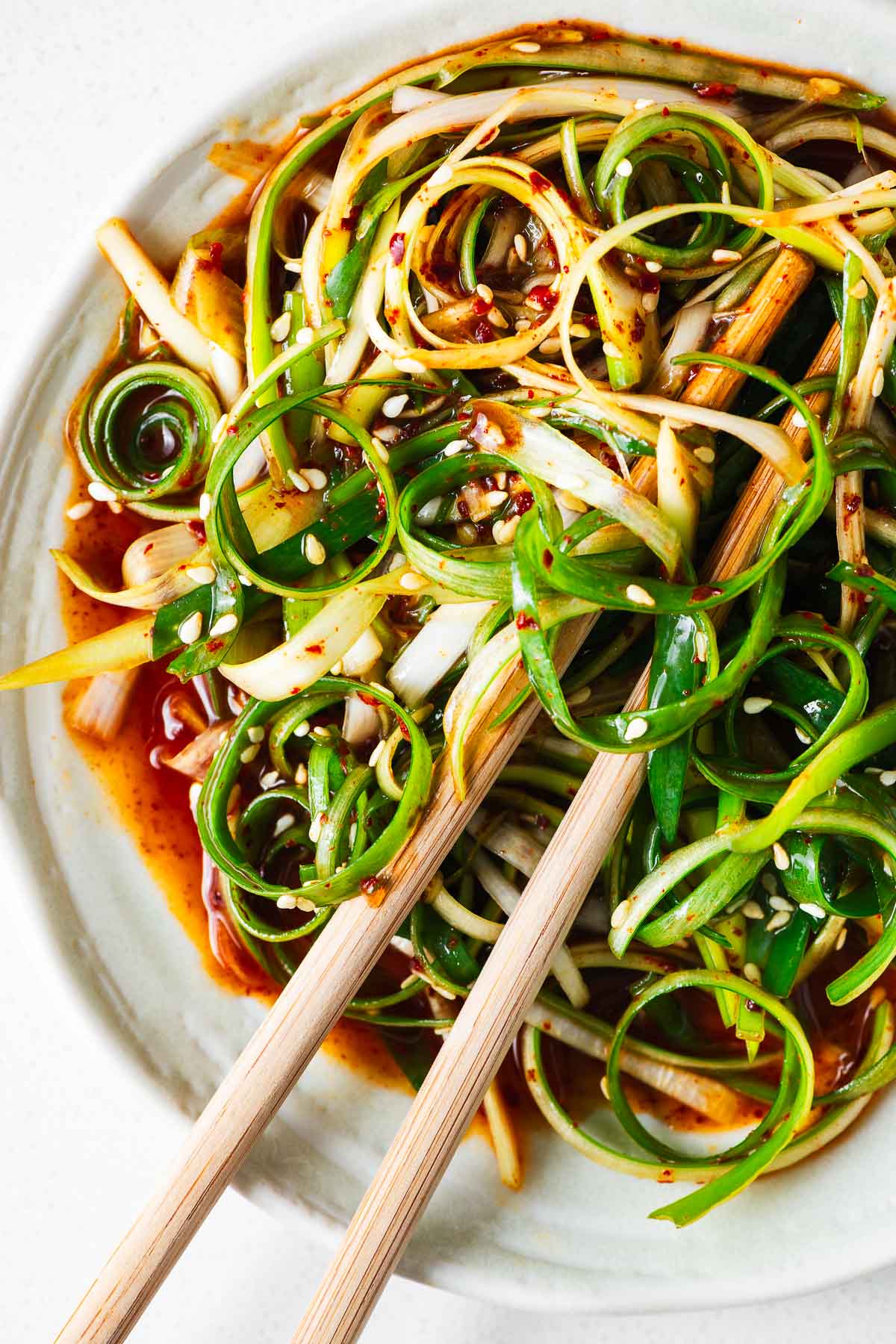
Why you’ll love this recipe
This sweet and savoury Korean banchan recipe adds freshness and crunch to any meal. But there are many more reasons to love this green onion salad recipe:
- It’s easy to make: This green onion salad is super easy to prepare. Buy pre-sliced green onions or grab a sharp knife (or green onion slicer) to slice some green onions, and whisk together a few pantry staples for the simple dressing. And just like that, you have a refreshing side salad!
- It’s deliciously versatile: Use the salad as a side dish with Korean mains. Or top your noodles, rice bowls or even falafel salad bowls. And you can easily adjust the heat to your liking by adding more or less of the gochugaru (Korean chilli flakes).
- It’s naturally vegan: The simple ingredients are plant-based. And if you need the green onion salad dressing to be gluten-free, use tamari or coconut aminos instead of soy sauce.
Ingredients and substitutes
Pa muchim is a light and refreshing side dish that comes together in no time. And it requires only a handful of ingredients.
- Green onion: You can buy pre-sliced scallions to save time. Otherwise, large green onions (or scallions) and a green onion slicer make light work of all the slicing. But you can also use small green onions – though the slicing requires a bit more concentration. If you have access to Korean dae-pa, you can use this too.
- Soy sauce: I use light or all-purpose soy sauce. But you can also use tamari or coconut aminos as a gluten-free option.
- Toasted sesame oil: Sesame oil is an essential ingredient in Korean cooking. It adds a nutty and savoury flavour to the salad.
- Rice vinegar: Rice vinegar adds a mild acidity to the salad. But you can also use apple cider vinegar or white wine vinegar.
- Gochugaru (Korean chilli flakes): Gochugaru adds a hint of spicy heat to the dish. If you don’t have gochugaru, here are some excellent gochugaru alternatives you might already have. Or omit for a non-spicy version.
- Sugar: I use granulated white sugar to balance the pungent allium flavour. You can also use raw sugar, honey, maple syrup, or coconut sugar for that touch of sweetness.
- Sesame seeds: Toasted sesame seeds add a nutty flavour and texture to the salad. You can buy roasted sesame seeds in Asian grocery stores. Or quickly toast sesame seeds in a dry pan over medium heat until they’re golden brown. You can also use black sesame seeds.
Learn how to to roast sesame seeds in the oven or to quickly toast them in a dry pan.
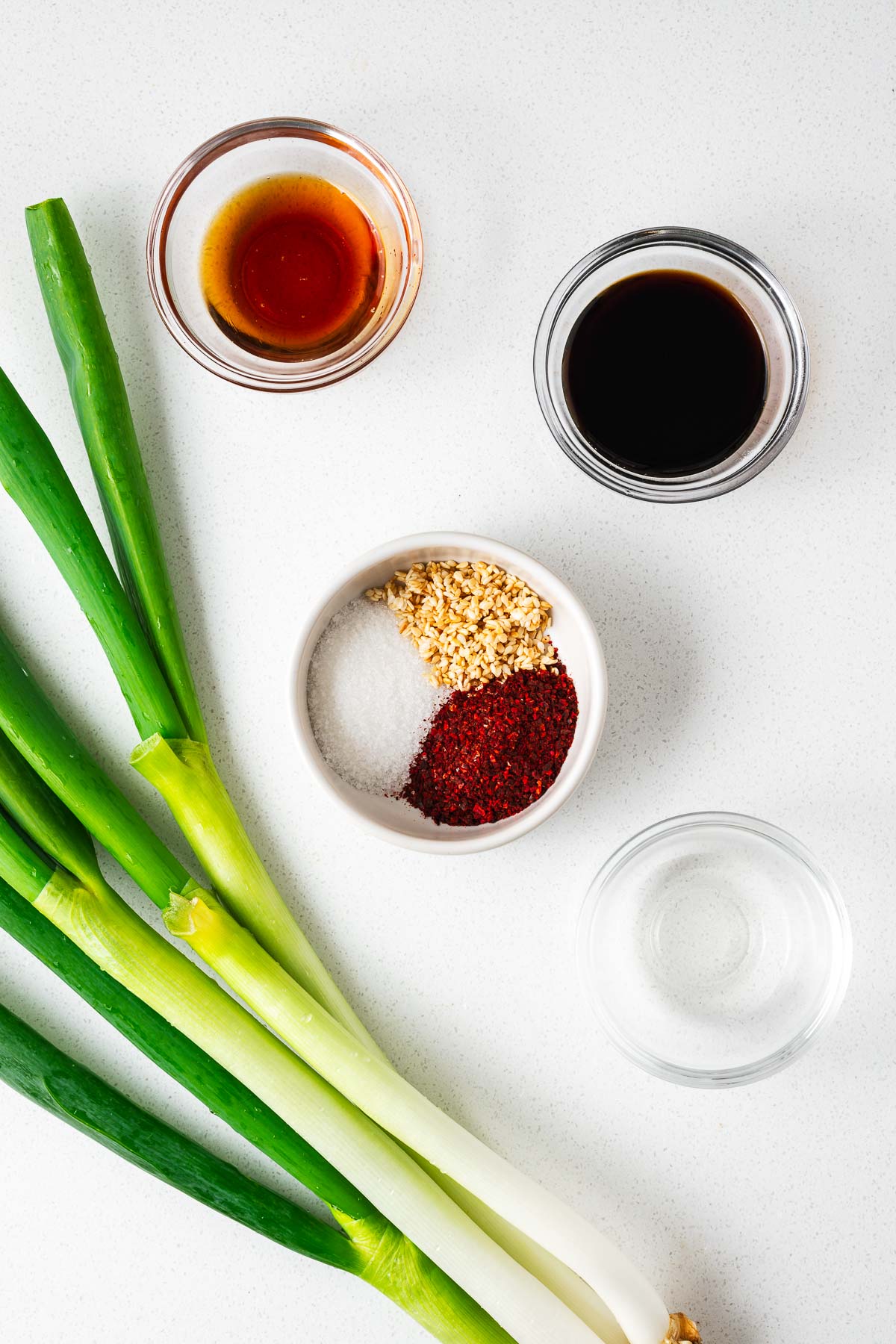
How to make Korean green onion salad
The key to great pa muchim is to slice the green onions super thin – either with a green onion shredder or a sharp knife. And then temper the onions in ice-cold water to reduce the pungency and preserve the crispness.
If you have pre-sliced green onions, start with step two.
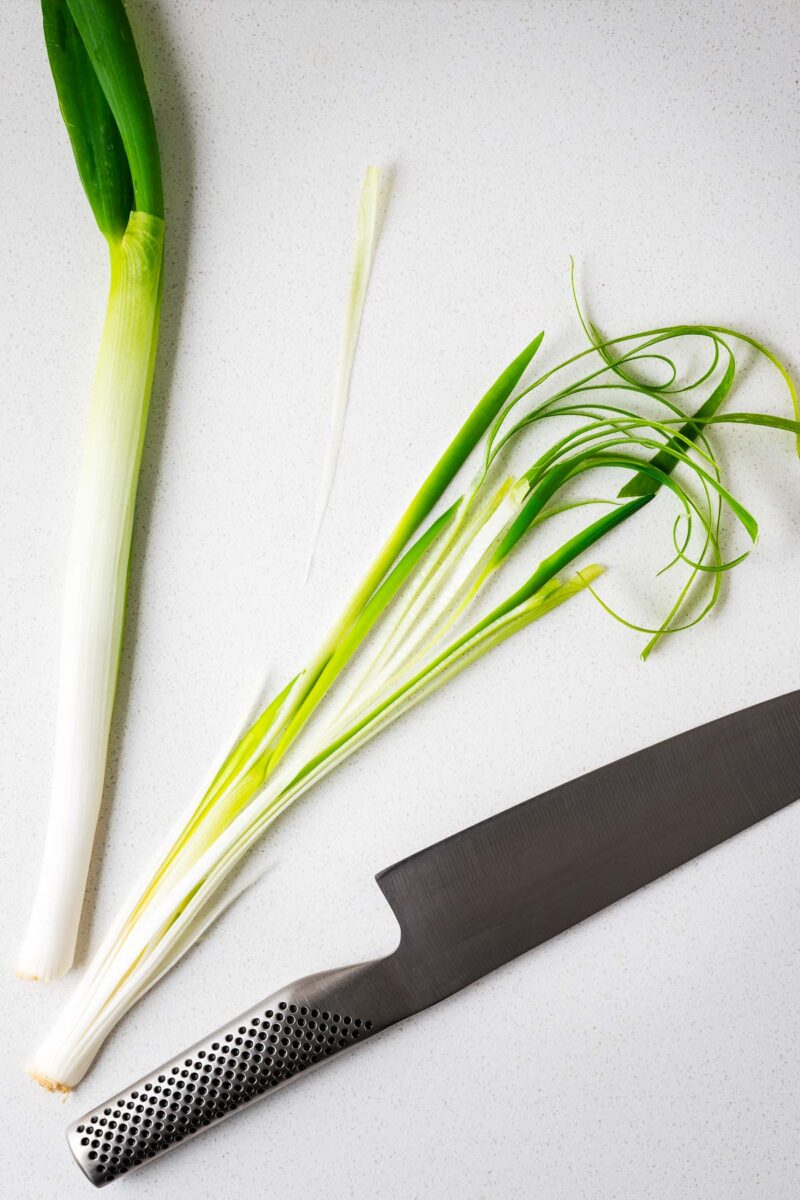
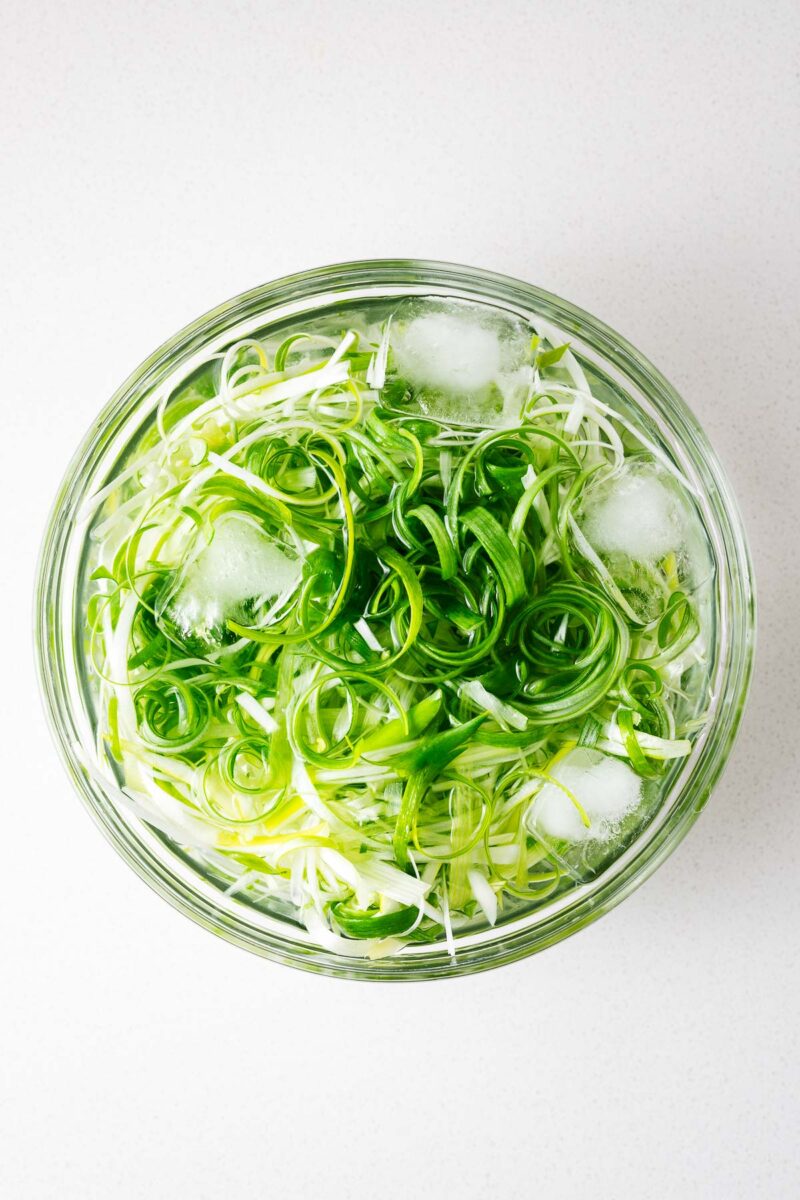
Step 1: Slice each green onion in half – keeping the root intact. Place the halves flat-side down on a cutting board. And slice it into thin strips with a green onion shredder or a sharp knife, starting at the root. Cut any long strips into smaller pieces, roughly 3 inches (7 cm) long. Discard the scallion root.
Step 2. Fill a bowl with cold water and a few blocks of ice. Then transfer the sliced green onions to the ice bath for five minutes while you make the dressing.
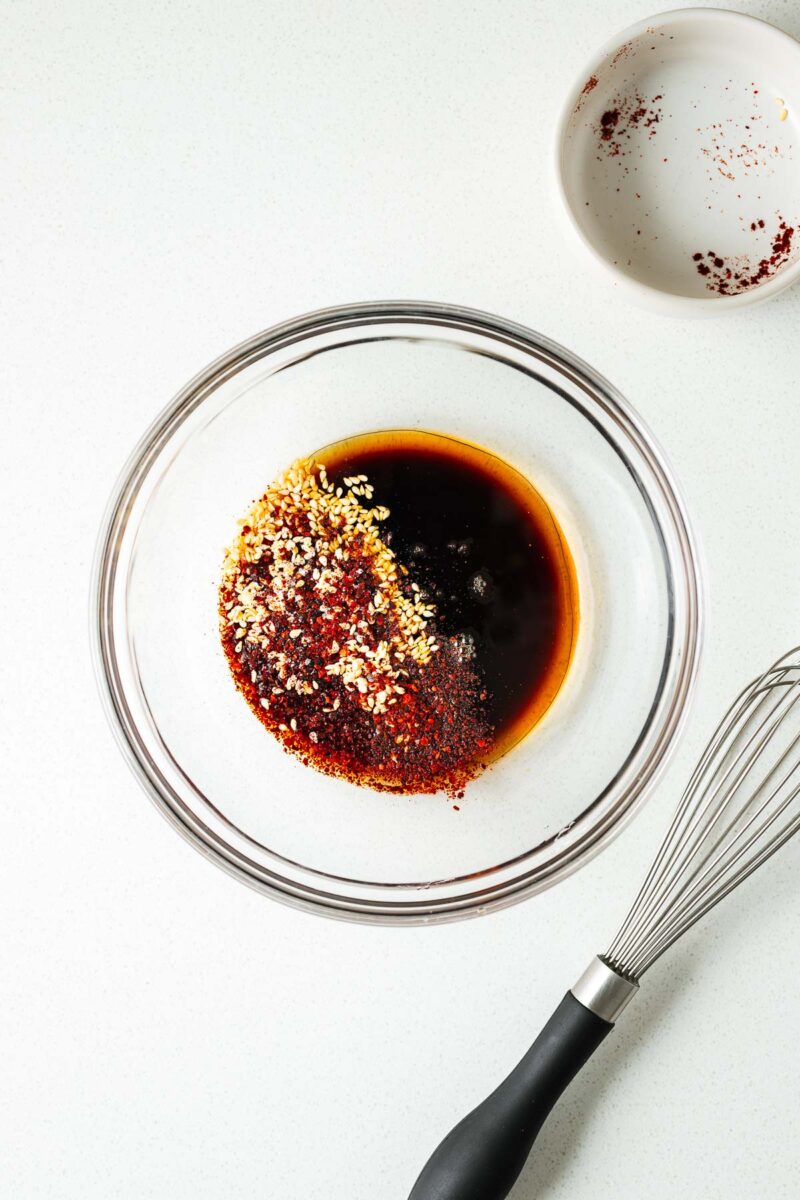
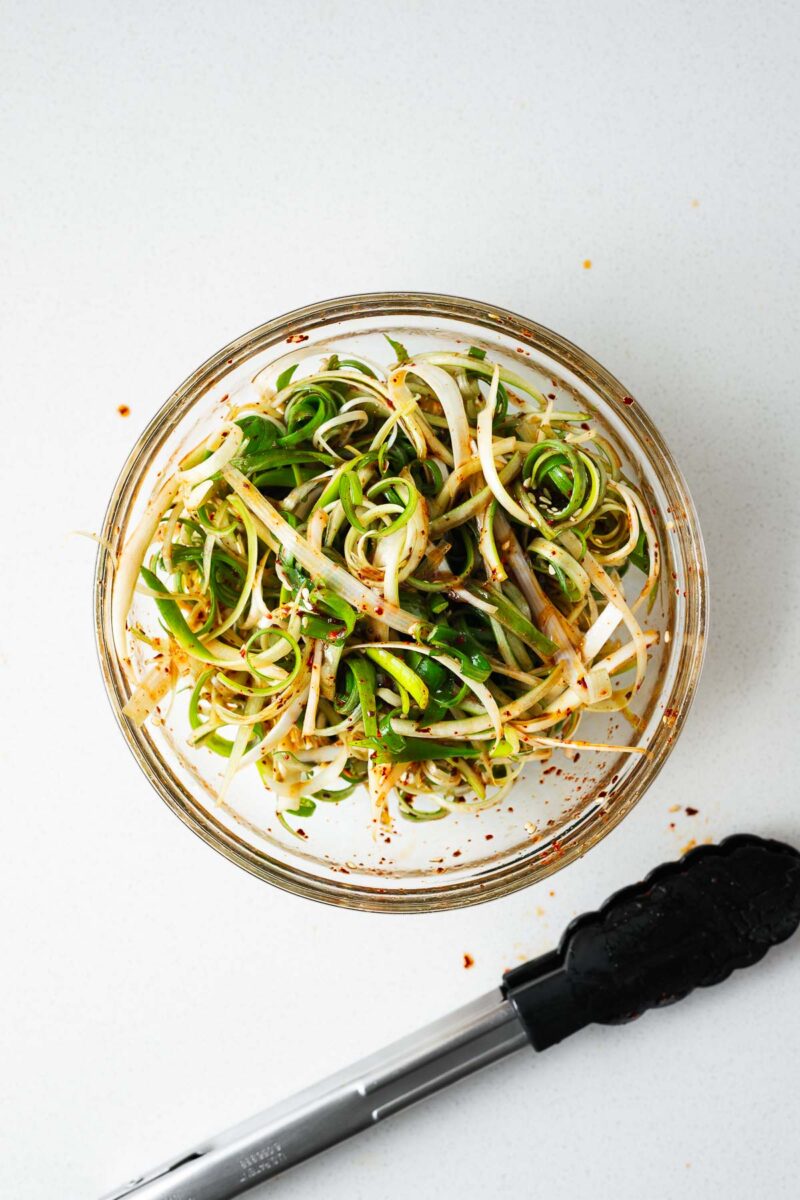
Step 3: Whisk together the scallion salad dressing in a large enough bowl to fit the green onion slivers:
- one tablespoon of soy sauce,
- one tablespoon of toasted sesame oil,
- two teaspoons of rice vinegar,
- one tablespoon of Korean chilli flakes,
- two teaspoons of sugar, and
- half a tablespoon of roasted sesame seeds.
Step 4: Assemble the green onion salad. Drain the green onions and gently pat them dry with a clean kitchen towel. Add them to the dressing and carefully toss to coat.
Storage instructions
The salad is best served fresh. If you want to get ahead, you can slice your green onions and make your dressing. Refrigerate both in separate clean airtight containers and mix just before serving.
What about leftover green onion salad?
You can safely refrigerate leftovers in a clean airtight container for up to three days. But the green onions will lose their crispy texture. They will look wilted and sad. Luckily they are delicious stirred through rice or cooked with stir-fries and noodles.
Serving suggestions
Korean banchan refers to the array of small side dishes served alongside a main course in Korean cuisine. These banchan can range from spicy and fermented (like kimchi) to light and refreshing (like this salad). Make a large spread of small plates and serve them family-style – to be shared and enjoyed by everyone at the table.
Serve this classic Korean banchan salad with more small plates like:
- sesame broccoli salad,
- spicy cucumber salad (oi muchim),
- soy-braised potatoes (gamja jorim) and
- traditional cabbage kimchi.
This Korean green onion salad is also great with Korean BBQ like beef bulgogi. It also works well with any fatty grilled meats like pork belly.
Or, to keep things vegan, serve it with Gochujang tofu (spicy Korean braised tofu) and a bowl of short-grain rice.
Stir leftover green onion salad into gochujang noodles or gochujang fried rice for a simple dinner.
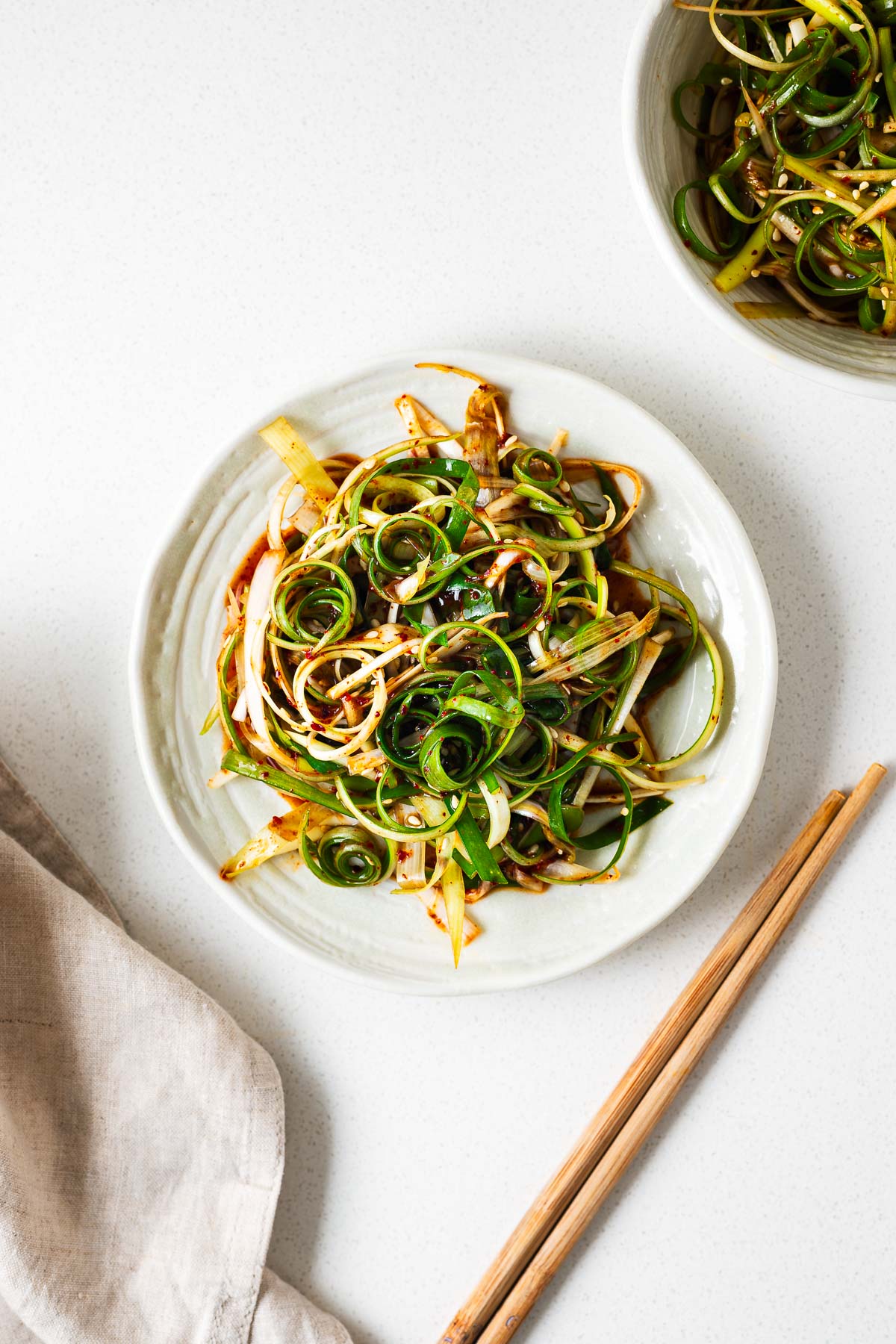
Frequently asked questions
Dae-pa (대파 ) is a Korean green onion. It is also a type of allium larger than normal green onions. They look like small leeks, but their green leaves are hollow and slightly slimy like green onions.
If you can’t find daepa (대파), substitute it with scallions (green onions) or spring onions. These are widely available in most grocery stores.
Pajeori (파절이) is also called pajuri, pachae muchim, or pamuchim. It’s a type of Korean green onion salad with thinly sliced Korean green onion and a dressing containing red pepper flakes (gochugaru), sesame oil and other seasonings. Korean restaurants usually serve it as a side dish along with more banchan.
Yes, green onions and scallions are the same thing. People use these terms interchangeably to describe an allium with a slender, green stalk and a small, white bulb. Outside the US, people often call them spring onions. However, in the US, spring onions can refer to a more mature green onion with a larger rounded bulb.

Ingredients
- 6 ounces green onions , about 4 large green onions
Green onion salad dressing
- 2 tablespoon soy sauce , light or all-purpose
- 1 tablespoon toasted sesame oil
- 2 teaspoons rice vinegar
- 2 teaspoons gochugaru (Korean chilli flakes), optional
- 2 teaspoons sugar
- ½ tablespoon sesame seeds , toasted
Instructions
- Slice each green onion in half – keeping the root intact. Place the halves flat-side down on a cutting board. And slice it into thin strips with a green onion shredder or a sharp knife, starting at the root. Cut any long strips into smaller pieces, roughly 3 inches (7 cm) long. Discard the scallion root. Then place the sliced green onions in a bowl of ice-cold water for 5 minutes while you make the dressing.
- In a large mixing bowl, whisk together the salad dressing ingredients.
- Drain the green onions and gently pat them dry with a clean kitchen towel. Add them to the dressing and lightly toss to coat.
Notes
- If you’re worried the green onion salad will be too spicy, start with half the gochugaru. Then taste the dressing before adding the remaining chilli flakes.
- The salad is best served fresh. If you want to get ahead, store the dressing and sliced green onions in separate airtight containers and only mix before serving. But you can refrigerate leftovers in a clean airtight container for up to 3 days and stir it into cooked dishes like noodles or egg-fried rice.
